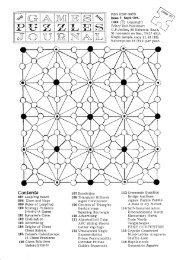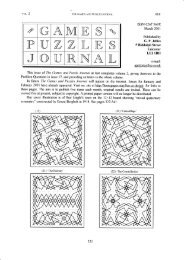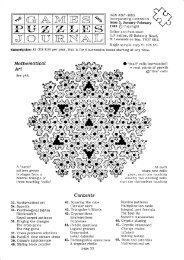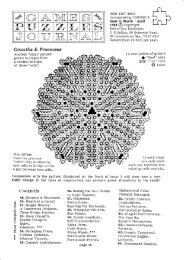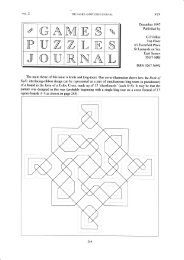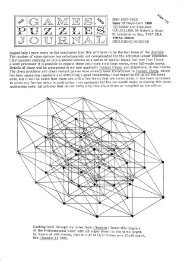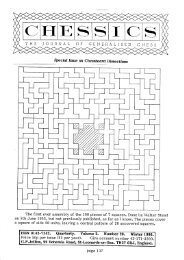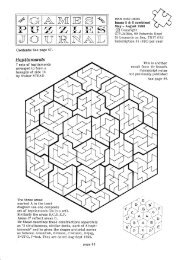The Games and Puzzles Journal, #8+9 - Mayhematics
The Games and Puzzles Journal, #8+9 - Mayhematics
The Games and Puzzles Journal, #8+9 - Mayhematics
You also want an ePaper? Increase the reach of your titles
YUMPU automatically turns print PDFs into web optimized ePapers that Google loves.
page 140 THE GAMES AND PUZZLES JOURNAL issue 8+9<br />
<strong>The</strong> diagrams show another series of<br />
<strong>The</strong> series here are not arithmetieal<br />
progressions, but are of the form<br />
trn..= 3un-1 + un-2<br />
A Gnornonic Questfon<br />
By T.H.I,VILLCOCKS<br />
solutions.<br />
n| '-T<br />
r-{l<br />
t_:1<br />
=L-:<br />
[-L_<br />
H<br />
Bridge Aucttons<br />
By Rev. R.A.DEARMAN<br />
<strong>The</strong>re is a misprint, 2 instead of 22, in the number of bidding sequences on p.113. And<br />
the comment following is obscure, to say the least! To construct a list of all valid sequences,<br />
assuming no irregularities such as insufficient bids condoned, we can proceed as follows: .-<br />
(1) {or each.level (1.C to_ ?N) independe4tly, choose any one of the 22 possibilities Pu, BPl,<br />
BDPi, BP2DPi, nDRpi, Bp2DRpi, edp2npi, b'p2op2npi, where i can be 0, 1 or 2, B=bid, p=pass,<br />
D=dblr R=rdbl: this gives 2235 stl'ings. (2) &emove P0: this leaves 2255-L, ali containing ai<br />
least one bid <strong>and</strong> alI ending in P0, F1 or p2. (g) Make all these endings up to P3: this_ gluut<br />
only (2235-r)/l distinct strings. (4) Precede each by P0, pt, p2 or P3: inis mates 412235J111g.<br />
(5) Append the string P4: this gives (+xZZ35-t)/3 as requirect.<br />
I submitted the conclusion, without any working, to <strong>Games</strong> & <strong>Puzzles</strong>: it was in No.2g,<br />
october 1974, p.27. As it says there, the problem was arousGFblTlEG-ii-No.25, June 19?4,<br />
p.29' which came in two parts, one identical to Ainley's second question [Wnat is the shortest<br />
possible bridge auction?1, the other (surprisingly not asked by Ainley) asking for the longest<br />
auction. <strong>The</strong> answers given (No.25, p.40), Iike Ainlels, assume that after ZNxx no morffi<br />
are made since each player has no legal alternative to a pass. I wrote to quibble that according<br />
to the rules the auction terminates after three (or four) consecutive passesf, so the shortest<br />
auctions consist of 4 calls <strong>and</strong> the longest of 319 (including three forced passes at the end):<br />
nearly 80 rounds! While I was at it I worked out the number of legal auctions <strong>and</strong> gave the<br />
answer in the form (+/g)12235-1)+1 [approx. t.gxtO4?]. As far as I kriow nobodv confirmed this<br />
"t ::"+tt:tYj'Iitlrlt'g"ction,- problem raises a question. often at bridge uo, ,nrnn there was<br />
nothing you could effectively have done to aveit a bad result. But of -course there are usually<br />
things you -cou!9 have done, like bidding 3NT, which might or might not have led to an even<br />
worse result. In what circumstances can an individual player say tnat (even with hindsight)<br />
there was absolutely nothing he could legalty do? As far as I can see the only answer is when<br />
the player on his left deals <strong>and</strong> opens ?NT, which is immediately doubled <strong>and</strong> redoubled, his<br />
partner makes a lead, <strong>and</strong> declarer claims 13 top tricks. This is nearly as bad as a snooker<br />
player watching his opponent break off <strong>and</strong> clear the table -rnearlyr, because bridge is a partnership<br />
game <strong>and</strong> the partner very definitely contributed to the debacle.<br />
*An analogy is when a player hgs-<br />
91ly one card in the suit led. He has no choice legally<br />
but to play it. Nevertfelgss he plays.it!-simitarty a player obliged to pass<br />
(or after an<br />
after<br />
irregutarity<br />
?Nxx) passes! <strong>The</strong> mort-i-Think about inis'tne more I am convinced. <strong>The</strong> answer 316<br />
given in G&P inttru-oes- two passes in- which tne piaver has no discreiion in the matter: ?NT,<br />
Pass, lasETouble / jltt, Putt,<br />
bDi<br />
soFa<br />
'F{<br />
1f,tr<br />
co<br />
oc<br />
Ebo<br />
ocd<br />
bE ao<br />
h cr-r<br />
gg<br />
{Jc<br />
FE oo<br />
EF'<br />
Fod<br />
ru<br />
E<br />
E k<br />
Redouble. By their reasoning they might as well take them<br />
as read so that only 314 calls are made. Of course these are mere technicalities, but the vast<br />
maJority of the possible sequences (including this one) are unimagin"ot" in practice, so we<br />
are. dealing with technicalities. Sometimes the technicality matters,'".g. declarer leads a spade<br />
<strong>and</strong> dummy has only the queen. Left-h<strong>and</strong> opponent hesitates, unsure irn"tn". it is better for<br />
self or partner to win. His partner is not aitbweC to decide ihe matter. <strong>The</strong> queen will have<br />
to be played but has not yet been played, even if dummy (annoyingly)'plays'it. r------:




